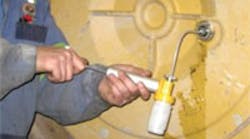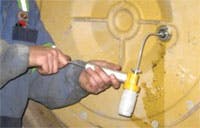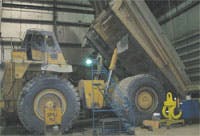Arming a knowledgeable techinician with diagnostic tools that measure pressure, flow, and temperature almost guarantees that the source of a machine malfunction will be found and corrected quickly. However, the best cure for a machine malfunction is to prevent it in the first place. So periodic assessment of a machine’s hydraulic system using these diagnostic tools can reveal trends that might ultimately lead to a component failure.
More often than not, though, the hydraulic fluid itself holds valuable evidence that can provide clues to potential problems. For example, fluid samples can indicate the quantity and nature of metal wear particles, dirt, water, and other contaminants. They may also contain products of oxidation — an indication that the fluid has been subjected to excessive heat.
Opportunities for ingression
Realizing the value of periodically sampling fluid — and that hydraulic equipment is usually surrounded by or encased in dirt — it’s important to follow specific procedures to prevent this dirt from getting into the hydraulic system when drawing a sample. Drawing a reliable oil sample from mobile equipment has always been risky because the hydraulic system must be exposed to the surrounding environment to extract fluid. This presents the potential for dirt, water, or other contaminants to enter the hydraulic system.
This is even more of a challenge when fluid must be drawn directly from a hydraulic motor. That’s because a tube must be inserted into the motor through an open port after removing an access plug. Contaminants can enter the system through the open port or stick to the tube and be injected into the fluid.
Contaminants won’t always enter a hydraulic system during sampling, but unless special effort is made to keep them out, there’s a good chance the cleanliness of the fluid wil be compromized.
Quick, easy, and clean
To avoid contaminating a machine’s hydraulic fluid — and without having to spend a lot of time and effort to get everything clean — a fluid sampling kit is available that minimizes the amount of work involved and dramatically reduces the likelihood of contamination entering a system. Offered by JLM Systems Ltd., Richmond, BC, Canada, the Oilmiser plug and sampling valve replace the access plug originally supplied with the motor.
The OilMiser plug and sampling valve is a three-piece assembly consisting of a steel hex plug, a check valve type sampling valve recessed into the plug, and a steel cap that threads into the plug to protect the sampling valve and keep contaminants away from it. The plug is available in standard sizes of SAE-12, -16, and -20, with other sizes optional. When fully assembled and installed, the plug body and cap protrude less than 1 in. beyond the mounting surface.
Unscrewing the cap exposes a cavity for easy access to the sampling valve. The mating half of the sampling valve is an OilMiser sampling probe, which connects to the sampling valve. A length of clean plastic sampling tube connects the back end of the sampling probe to a vacuum pump and a clean sample bottle. Pulling on the pump’s handle draws fluid from the hydraulic system and deposits it into the sample bottle.
This closed-loop circuit ensures that no ambient contamination can enter the oil sample. Only when the sampling probe is fully engaged with the sampling valve can fluid be drawn. The sampling valve resets when the sampling probe is disconnected.
For more information, contact JLM systems Ltd. at (604) 521-3248, email [email protected], or visit www.oilmiser.com.




